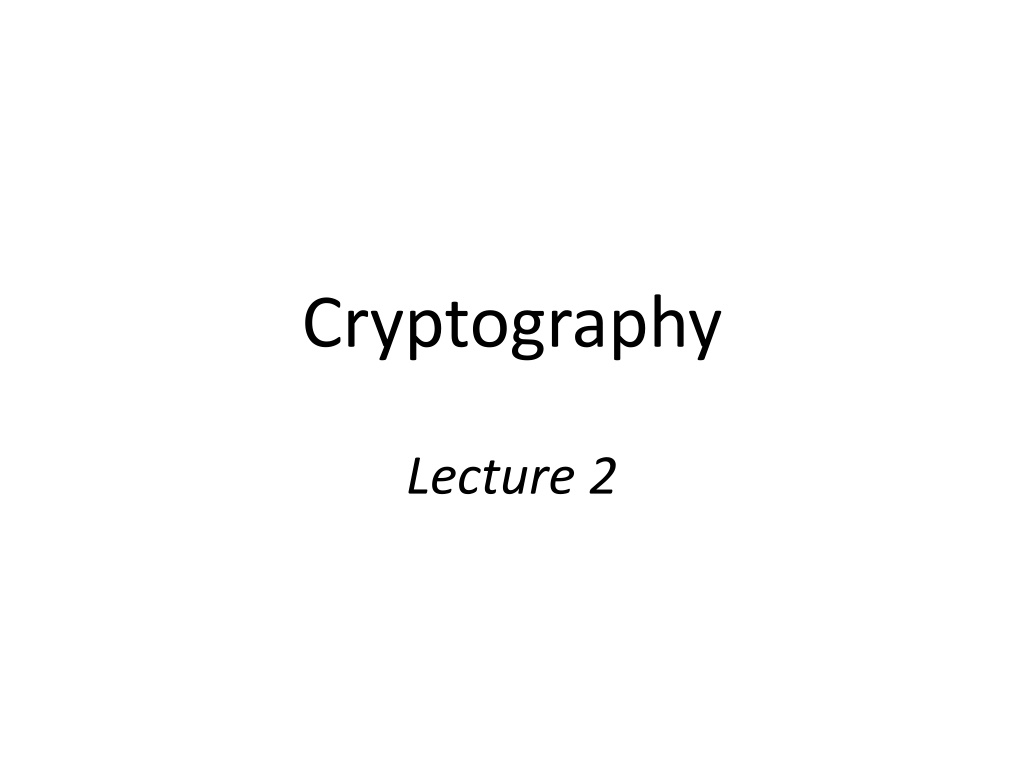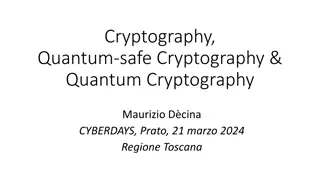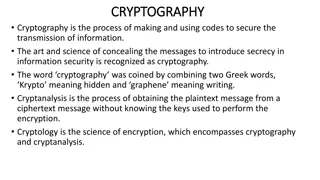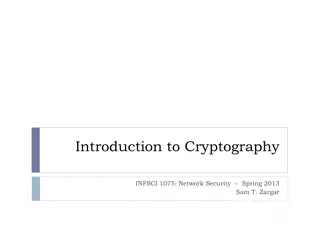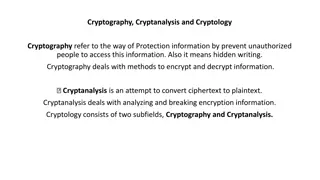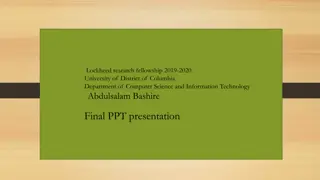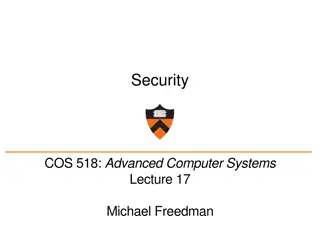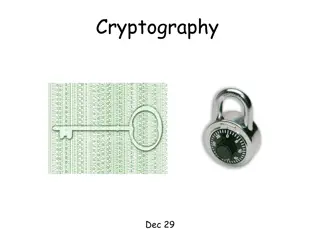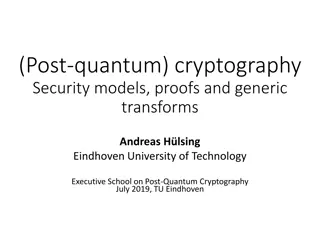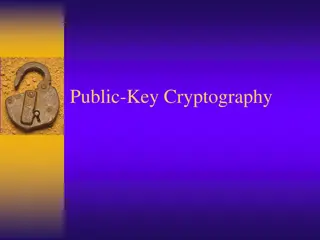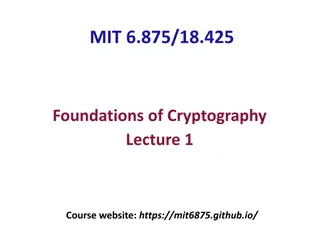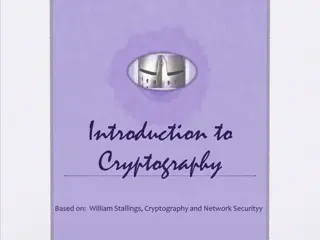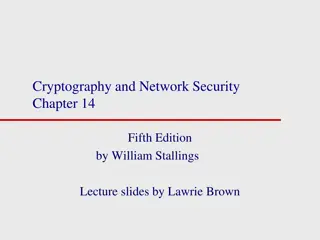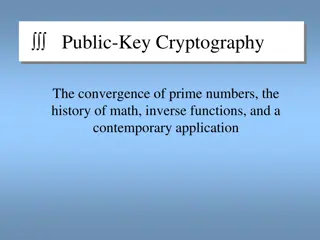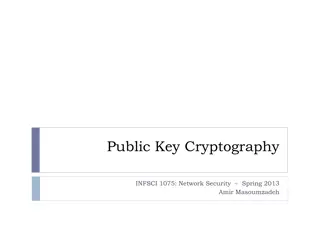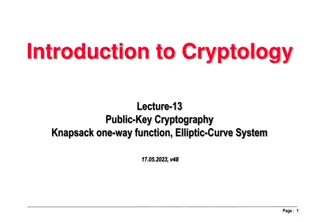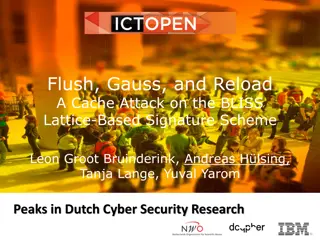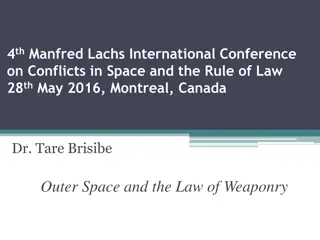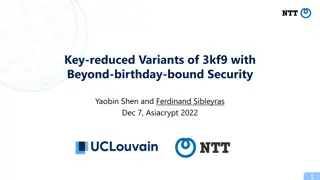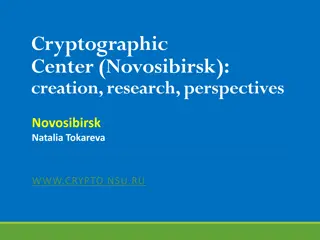Key Principles in Cryptography: Kerckhoff's and Key Space
Understanding fundamental principles in cryptography, including Kerckhoff's principle, key space requirements, and the importance of secure private-key encryption. Exploring the Shift Cipher's security, key space size considerations, and the need for heuristic constructions for proving scheme security.
Download Presentation

Please find below an Image/Link to download the presentation.
The content on the website is provided AS IS for your information and personal use only. It may not be sold, licensed, or shared on other websites without obtaining consent from the author. Download presentation by click this link. If you encounter any issues during the download, it is possible that the publisher has removed the file from their server.
E N D
Presentation Transcript
Cryptography Lecture 2
Announcements Quiz Thursday 10 minutes Closed-book quiz
Survey How many of you read the chapters I ask you to? How many of you are from math department? How many of you learned some preliminary crypto in some other classes? How many of you are comfortable with proofs and theorems throughout the semester?
Kerckhoffss principle The encryption scheme is not secret The attacker knows the encryption scheme The only secret is the key The key must be chosen at random; kept secret Some arguments in favor of this principle Easier to keep key secret than algorithm Easier to change key than to change algorithm Standardization Ease of deployment Public validation
Is the Shift Cipher secure? No -- only 26 possible keys! Given a ciphertext, try decrypting with every possible key If ciphertext is long enough, only one plaintext will make sense Does it violate the Kerckhoffs s principle?
Sufficient key space principle The key space must be large enough to make exhaustive-search attacks impractical How large do you think that is? Note: this makes some assumptions English-language plaintext Ciphertext sufficiently long so only one valid plaintext
If both Sufficient Key Space Principle and Kerckhoffs s Principle are satisfied Do you have a secure private-key encryption? If yes, why? If not, why?
So far Heuristic constructions; construct, break, repeat, Can we prove that some encryption scheme is secure? First need to define what we mean by secure in the first place
Historically Cryptography was an art Heuristic, ad hoc design and analysis This isn t very satisfying How do we know when a scheme is secure?
Modern cryptography In the late 70s and early 80s, cryptography began to develop into more of a science Based on three principles that underpin most crypto work today
Core principles of modern crypto Formal definitions Precise, mathematical model and definition of what security means Assumptions Clearly stated and unambiguous Proofs of security Move away from design-break-patch
Importance of definitions Definitions are essential for the design, analysis, and usage of crypto
Importance of definitions -- design Developing a precise definition forces the designer to think about what they really want What is essential and (sometimes more important) what is not Often reveals subtleties of the problem
Importance of definitions -- design If you don t understand what you want to achieve, how can you possibly know when (or if) you have achieved it?
Importance of definitions -- analysis Definitions enable meaningful analysis, evaluation, and comparison of schemes Does a scheme satisfy the definition? What definition does it satisfy? Note: there may be multiple meaningful definitions! One scheme may be less efficient than another, yet satisfy a stronger security definition
Importance of definitions -- usage Definitions allow others to understand the security guarantees provided by a scheme Enables schemes to be used as components of a larger system (modularity) Enables one scheme to be substituted for another if they satisfy the same definition
Assumptions With few exceptions, cryptography currently requires computational assumptions At least until we prove P NP (and even that would not be enough) Principle: any such assumptions should be made explicit
Importance of clear assumptions Allow researchers to (attempt to) validate assumptions by studying them Allow meaningful comparison between schemes based on different assumptions Useful to understand minimal assumptions needed Practical implications if assumptions are wrong Enable proofs of security
Proofs of security Provide a rigorous proof that a construction satisfies a given definition under certain specified assumptions Provides an iron-clad guarantee (relative to your definition and assumptions!) Proofs are crucial in cryptography, where there is a malicious attacker trying to break the scheme
Limitations? Cryptography remains partly an art as well Given a proof of security based on some assumption, we still need to instantiate the assumption Validity of various assumptions is an active area of research Why? NP=P? Other limitations? Discuss!
Limitations? Proofs given an iron-clad guarantee of security relative to the definition and the assumptions! Provably secure schemes can be broken! If the definition does not correspond to the real-world threat model I.e., if attacker can go outside the security model This happens a lot in practice If the assumption is invalid If the implementation is flawed This happens a lot in practice
Nevertheless This does not detract from the importance of having formal definitions in place This does not detract from the importance of proofs of security
Crypto definitions (generally) Security guarantee/goal What we want to achieve and/or what we want to prevent the attacker from achieving Threat model What (real-world) capabilities the attacker is assumed to have
Recall A private-key encryption scheme is defined by a message space M M and algorithms (Gen, Enc, Dec): Gen (key-generation algorithm): generates k Enc (encryption algorithm): takes key k and message m M M as input; outputs ciphertext c c Enck(m) Dec (decryption algorithm): takes key k and ciphertext c as input; outputs m. m := Deck(c)
Private-key encryption key key ciphertext c k k m m := Deck(c) c := Enck(m) message/plaintext decryption encryption
Threat models for encryption Ciphertext-only attack One ciphertext or many? Known-plaintext attack Chosen-plaintext attack Chosen-ciphertext attack
Goal of secure encryption? How would you define what it means for encryption scheme (Gen, Enc, Dec) over message space M M to be secure? Against a (single) ciphertext-only attack
Secure encryption? Impossible for the attacker to learn the key The key is a means to an end, not the end itself Necessary (to some extent) but not sufficient Easy to design an encryption scheme that hides the key completely, but is insecure Can design schemes where most of the key is leaked, but the scheme is still secure
Secure encryption? Impossible for the attacker to learn the plaintext from the ciphertext What if the attacker learns 90% of the plaintext?
Secure encryption? Impossible for the attacker to learn any character of the plaintext from the ciphertext What if the attacker is able to learn (other) partial information about the plaintext? E.g., salary is greater than $75K What if the attacker guesses a character correctly?
Perfect secrecy Regardless of any prior information the attacker has about the plaintext, the ciphertext should leak no additional information about the plaintext The right notion! How to formalize?
Probability review Random variable (r.v.): variable that takes on (discrete) values with certain probabilities Probability distribution for a r.v. specifies the probabilities with which the variable takes on each possible value Each probability must be between 0 and 1 The probabilities must sum to 1
Probability review Event: a particular occurrence in some experiment Pr[E]: probability of event E Conditional probability: probability that one event occurs, given that some other event occurred Pr[A | B] = Pr[A and B]/Pr[B] Two r.v. s X, Y are independent if for all x, y: Pr[X=x | Y=y] = Pr[X=x]
Probability review Law of total probability: say E1, , En are a partition of all possibilities. Then for any A: Pr[A] = i Pr[A and Ei] = i Pr[A | Ei] Pr[Ei]
Notation K K(key space) set of all possible keys C C (ciphertext space) set of all possible ciphertexts
Probability distributions Let M be the random variable denoting the value of the message M ranges over M M This reflects the likelihood of different messages being sent by the parties, given the attacker s prior knowledge E.g., Pr[M = attack today ] = 0.7 Pr[M = don t attack ] = 0.3
Probability distributions Let K be a random variable denoting the key K ranges over K K Fix some encryption scheme (Gen, Enc, Dec) Gen defines a probability distribution for K: Pr[K = k] = Pr[Gen outputs key k]
Probability distributions Random variables M and K are independent I.e., the message that a party sends does not depend on the key used to encrypt that message
Probability distributions Fix some encryption scheme (Gen, Enc, Dec), and some distribution for M Consider the following (randomized) experiment: 1. Choose a message m, according to the given distribution 2. Generate a key k using Gen 3. Compute c Enck(m) This defines a distribution on the ciphertext! Let C be a random variable denoting the value of the ciphertext in this experiment
Example 1 Consider the shift cipher So for all k {0, , 25}, Pr[K = k] = 1/26 Say Pr[M = a ] = 0.7, Pr[M = z ] = 0.3 What is Pr[C = b ] ? Either M = a and K = 1, or M = z and K = 2 Pr[C= b ] = Pr[M= a ] Pr[K=1] + Pr[M= z ] Pr[K=2] Pr[C= b ] = 0.7 (1/26) + 0.3 (1/26) Pr[C= b ] = 1/26
Example 2 Consider the shift cipher, and the distribution Pr[M = one ] = , Pr[M = ten ] = Pr[C = rqh ] = ? = Pr[C = rqh | M = one ] Pr[M = one ] + Pr[ C = rqh | M = ten ] Pr[M = ten ] = 1/26 + 0 = 1/52
Perfect secrecy (informal) Regardless of any prior information the attacker has about the plaintext, the ciphertext should leak no additional information about the plaintext
Perfect secrecy (informal) Attacker s information about the plaintext = attacker-known distribution of M Perfect secrecy means that observing the ciphertext should not change the attacker s knowledge about the distribution of M
Perfect secrecy (formal) Encryption scheme (Gen, Enc, Dec) with message space M M and ciphertext space C C is perfectly secret if for every distribution over M M, every m M M, and every c C Cwith Pr[C=c] > 0, it holds that Pr[M = m | C = c] = Pr[M = m]. I.e., the distribution of M does not change conditioned on observing the ciphertext
Example 3 Consider the shift cipher, and the distribution Pr[M = one ] = , Pr[M = ten ] = Take m = ten and c = rqh Pr[M = ten | C = rqh ] = ? = 0 Pr[M = ten ]
Conclusion The shift cipher is not perfectly secret! How to construct a perfectly secret scheme?
One-time pad Patented in 1917 by Vernam Recent historical research indicates it was invented (at least) 35 years earlier Proven perfectly secret by Shannon (1949)
One-time pad Let M M = {0,1}n Gen: choose a uniform key k {0,1}n Enck(m) = k m Deck(c) = k c Correctness: Deck( Enck(m) ) = k (k m) = (k k) m = m
